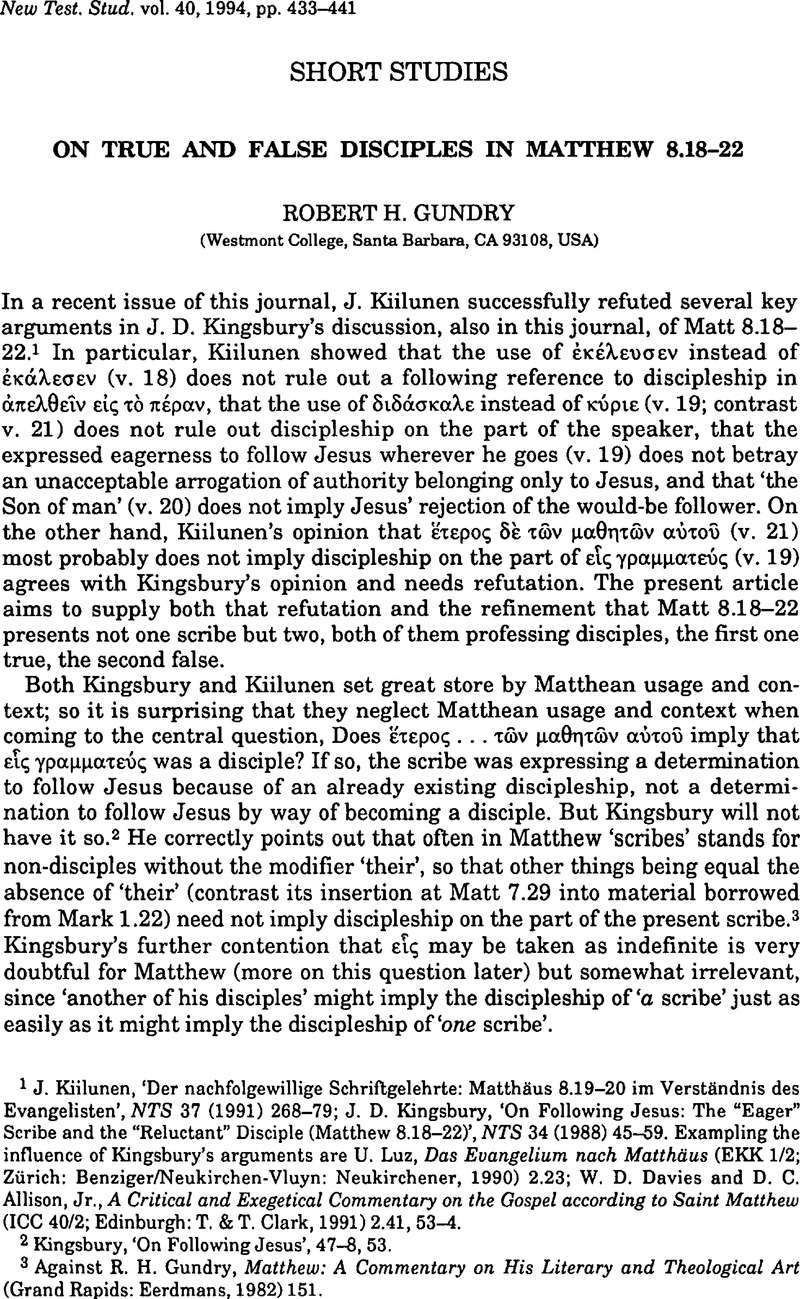Published online by Cambridge University Press: 05 February 2009

1 Kiilunen, J., ‘Der nachfolgewillige Schriftgelehrte: Matthäus 8.19–20 im Verständnis des Evangelisten’, NTS 37 (1991) 268–79Google Scholar; Kingsbury, J. D., ‘On Following Jesus: The “Eager” Scribe and the “Reluctant” Disciple (Matthew 8.18–22)’, NTS 34 (1988) 45–59Google Scholar. Exampling the influence of Kingsbury's arguments are Luz, U., Das Evangelium nach Matthäus (EKK 1/2; Zürich: Benziger/Neukirchen-Vluyn: Neukirchener, 1990) 2.23Google Scholar; Davies, W. D. and Allison, D. C. Jr, A Critical and Exegetical Commentary on the Gospel according to Saint Matthew (ICC 40/2; Edinburgh: T. & T. Clark, 1991) 2.41, 53–4.Google Scholar
2 Kingsbury, ‘On Following Jesus’, 47–8, 53.
3 Against Gundry, R. H., Matthew: A Commentary on His Literary and Theological Art (Grand Rapids: Eerdmans, 1982) 151.Google Scholar
4 Kiilunen, ‘Der nachfolgewillige Schriftgelehrte’, 275.
5 To be sure, there is a text critical question in Matt 21.30. Though ℵ* C* Koine Text D W Δ Θ f13 157 1241 pm read τέρῳ, ℵ2 B C2 L Z f1 33 700 892 1424 pm mae bo read δευτρῳ. Most likely, however, δευτέρῳ arose out of the preceding πρώτῳ. After πρώτῳ, what scribe would have changed δευτέρῳ to τέρῳ?
6 Αὐτο is lacking in ℵ B 33 pc it sa, and present in C L W Θ 0250 f1,13 Majority Text lat sy mae bo. This difference does not affect the present discussion.
7 These statistics presume the pericopal boundaries in K. Aland's Synopsis. The boundaries in other synopses would make no appreciable difference.
8 For an authoritative discussion of Matt 13.52; 23.24, see Orton, D. E., The Understanding Scribe: Matthew and the Apocalyptic Ideal (JSNTSup 25; Sheffield: JSOT, 1989) 137–63Google Scholar, and indeed the entire book on Matthew's portrayal of Jesus' disciples as scribes.
9 Kiilunen, ‘Der nachfolgewillige Schriftgelehrte’, 275.
10 Against Davies and Allison, Matthew, 2.41. See Gundry, Matthew, 410.
11 Against Davies and Allison, Matthew, 2.41. Luke 22.56, 58 refers first to ‘a certain maid’ (παιδίσκη τις) and then to ‘another one [a man]’ (ἕτερος).
12 Cf. Maloney, E. C., Semitic Interference in Marcan Syntax (SBLDS 51; Chico: Scholars, 1981) 126–31Google Scholar, and the emphasis on oneness in elliptical expressions at Matt 6.24 (bis); 17.4; 18.16; 20.21; 24.40, 41; 25.18; 27.15, 38.
13 Kingsbury, ‘On Following Jesus’, 48 (italics added).
14 Cf. Uro, R., Sheep Among the Wolves: A Study on the Mission Instructions of Q (AASF Diss. Human. Litt. 47; Helsinki: Suomalainen Tiedeakatemia, 1987) 90–1.Google Scholar
15 The further parallel Luke 8.22 has οἱ μαθητα αὐτο, but for the possibility of subsidiary Matthean influence on Luke, though not at the expense of the Mark-Q hypothesis, see Gundry, R. H., ‘Matthean Foreign Bodies in Agreements of Luke with Matthew Against Mark: Evidence That Luke Used Matthew’, The Four Gospels 1992 (Neirynck, F. FS; ed. Segbroek, F. van et al. ; BETL 100; Leuven: Leuven UP/Peeters, 1992) 1467–95.Google Scholar
16 Cf. the suggestion of Wire, A. C. (in Social History of the Matthean Community: Cross-Disciplinary Approaches [ed. Balch, D. L.; Minneapolis: Fortress, 1991] 103Google Scholar, n. 57) that the scribe and the other one of the disciples ‘could well be intended to refer to some among those later chosen as the Twelve, since they [the Twelve] are not named and given authority until 10:1–16’.
17 Fleddermann, H. (in The Four Gospels 1992 [Neirynck, F. FS; ed. Segbroeck, F. Van et al. ; BETL 100; Leuven: Leuven UP/Peeters, 1992] 548–52)Google Scholar cites others who support the inclusion by Q of another would-be delayer, but himself argues for fabrication by Luke. Yet the Lucanisms to which Fleddermann appeals could well derive from Luke's redaction of Q, and Fleddermann's appeal to perseverance as a characteristically Lucan theme misconstrues Jesus' brooking no delay as a call to perseverance. One must start before one can persevere.
18 Cf. Gundry, Matthew, 649, s.v. ‘Corpus mixtum’.
19 Matthew may draw κύριε from tradition behind Luke 9.61 (see Metzger, B. M., A Textual Commentary on the Greek New Testament [New York: United Bible Societies, 1971] 149Google Scholar, on the text-critical question in Luke 9.61). If so, we have more evidence of his deliberate omission of the other would-be delayer mentioned in Luke 9.61–2.
20 Kingsbury, ‘On Following Jesus’, 53–4.
21 On further de-accentuation of Matthew's ecclesiology, see the review by Gundry, R. H. in Bib 71 (1990) 126–9Google Scholar of Bauer's, D. R.The Structure of Matthew's Gospel: A Study in Literary Design (JSNTSup 31; Sheffield: Almond, 1988)Google Scholar. As a doctoral student, Bauer wrote his book under Kingsbury's tutelage and with the intent of carrying out Kingsbury's programme.
22 Zahn, T., Das Evangelium des Matthäus (3. Aufl.; ZahnK 1; Leipzig: Deichert, 1910) 348–49.Google Scholar
23 Davies and Allison, Matthew, 2.41.
24 Kingsbury, ‘On Following Jesus’, 51, 58, nn. 33–6.
25 Kiilunen, ‘Der nachfolgewillige Schriftgelehrte’, 274.
26 See Gundry, Matthew, 195, for probably Matthean redaction of tradition behind Luke 6.40.
27 Cf. also Kingsbury, J. D., Matthew: Structure, Christology, Kingdom (Philadelphia: Fortress, 1975) 113.Google Scholar